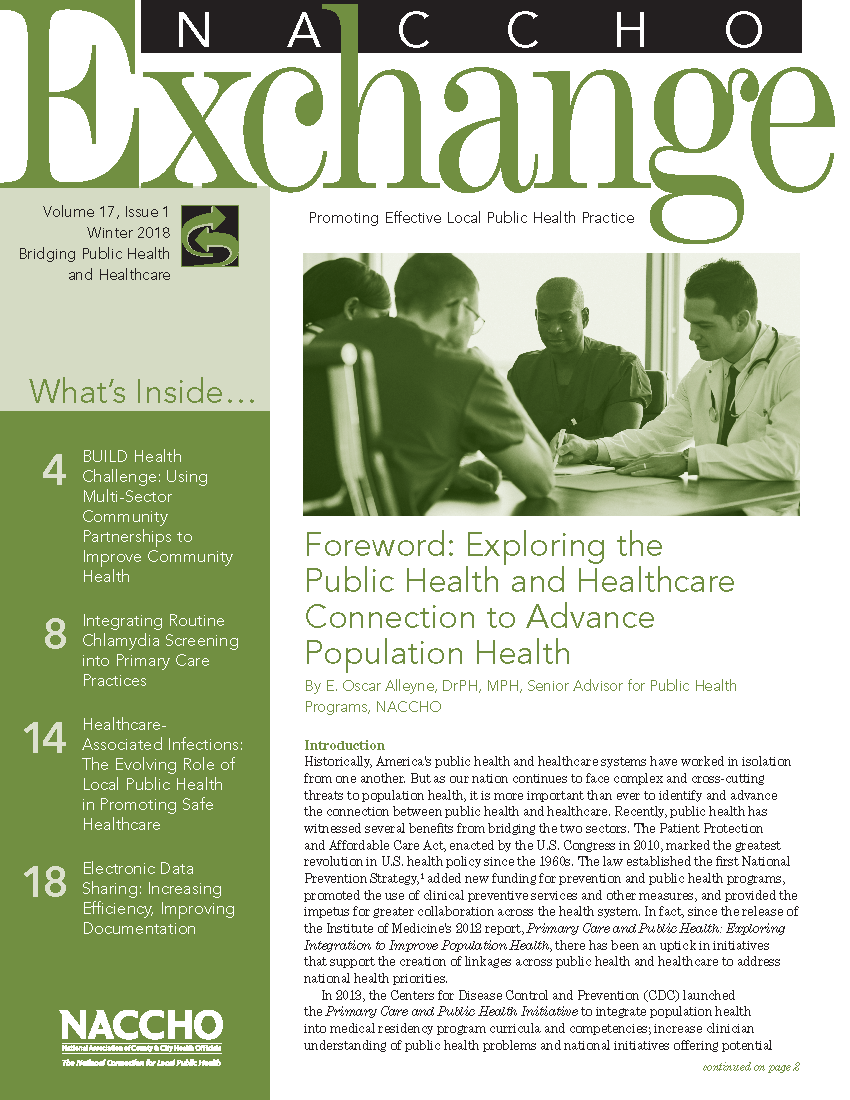 By E. Oscar Alleyne, DrPH, MPH, Senior Advisor for Public Health Programs, NACCHO
By E. Oscar Alleyne, DrPH, MPH, Senior Advisor for Public Health Programs, NACCHO
The following is an excerpt from the winter issue of NACCHO Exchange.
Introduction
Historically, America’s public health and healthcare systems have worked in isolation from one another. But as our nation continues to face complex and cross-cutting threats to population health, it is more important than ever to identify and advance the connection between public health and healthcare. Recently, public health has witnessed several benefits from bridging the two sectors. The Patient Protection and Affordable Care Act, enacted by the U.S. Congress in 2010, marked the greatest revolution in U.S. health policy since the 1960s. The law established the first National Prevention Strategy,1 added new funding for prevention and public health programs, promoted the use of clinical preventive services and other measures, and provided the impetus for greater collaboration across the health system. In fact, since the release of the Institute of Medicine’s 2012 report, Primary Care and Public Health: Exploring Integration to Improve Population Health, there has been an uptick in initiatives that support the creation of linkages across public health and healthcare to address national health priorities.
In 2013, the Centers for Disease Control and Prevention (CDC) launched the Primary Care and Public Health Initiative to integrate population health into medical residency program curricula and competencies; increase clinician understanding of public health problems and national initiatives offering potential solutions; and increase clinician awareness and use of CDC resources. Three years later, the de Beaumont Foundation, in partnership with CDC and Duke University Community & Family Medicine, developed the Practical Playbook: Public Health and Primary Care Together to advance collaboration between public health and primary care. The Practical Playbook aims to improve population health by providing practical implementation tools, guidance, and resources.3 NACCHO began exploring this issue at its 2017 annual conference, themed “Public Health Revolution: Bridging Clinical Medicine and Population Health.” The conference highlighted successes and challenges related to linking public health and clinical medicine; managing systems that measure health and healthcare outcomes; and advancing population health. Through these discussions, one thing became very clear: in order to bridge the gap between healthcare and public health, there must be strong local level involvement.
Improving Population Health at the Local Level
While ‘population health’ is a term that could mean slightly different things depending on who you ask, the broad definition is “the health outcomes of a group of individuals, including the distribution of such outcomes within the group.”4 While these outcomes are partially influenced by genetics and individual behaviors, they are also a result of the social determinants of health, which include economic stability, education, social and community context, health and healthcare, and neighborhood and built environment. Social determinants reflect the conditions of the environments in which people are born, live, learn, work, play, worship, and age, and they affect a wide range of health, functioning, and quality-of-life outcomes and risks.5 Being the boots-on-the-ground, local health departments (LHDs) are well-positioned to address the social determinants that impact health in their communities, thereby improving health outcomes and, consequently, population health. In particular, with more departments adopting the role of Community Health Strategist,6 an increasing number of local public health leaders are spearheading efforts to:
- Interpret data and diagnose the implications on a community scale;
- Illuminate health inequities and encourage social justice;
- Partner with non-health sectors working toward a culture of health;
- Broaden local policymakers’ understanding of health inequities and health outcomes;
- Convene and support community organizations; and,
- Identify evidence-based strategies for improving population health.
Through these efforts, LHDs are demonstrating a commitment to be more nimble and viable, while embracing comprehensive strategies for delivering care to their communities. For example, more than half of local public health agencies (61%) encourage primary care providers to use evidence-based public health services, such as interventions to reduce asthma triggers in children’s home environments.7 But despite their desire to explore new ways to collaborate with healthcare entities, challenges still exist. In particular, funding for partnership activities and competing priorities are a major roadblock to developing these partnerships.8 Still, in the face of increasingly complex health challenges, LHDs are finding ways to adapt to the changing public health system and continue to increase their involvement in multi-sectoral partnerships on issues disproportionately affecting their communities.
Read more in the winter issue of NACCHO Exchange.
References
- Office of the U.S. Surgeon General. National prevention strategy. Retrieved from https://www.surgeongeneral.gov/priorities/prevention/strategy/index.html
- Centers for Disease Control and Prevention. (2016). Primary care and public health initiative. Retrieved from https://www.cdc.gov/ophss/csels/dsepd/academic-partnerships/wip/primarycare.html
- de Beaumont Foundation. (2016). Practical playbook: Public health and primary care together. Retrieved from http://www.debeaumont.org/practical-playbook/
- Kindig, D. and Stoddart, G. (2003). What is population health? American Journal of Public Health, 93(3), 380-383. Retrieved from https://www.ncbi.nlm.nih.gov/pmc/ articles/PMC1447747/
- Healthy People 2020. (2010). Social determinants of health. Retrieved from https://www.healthypeople.gov/2020/topics-objectives/topic/social-determinants-of-health
- National Association of County and City Health Officials. (2016). Public Health 3.0 issue brief. Retrieved from http://bit.ly/2DAofAx
- National Association of County and City Health Officials. (2015). 2015 forces of change survey. Retrieved from http://bit.ly/2Dr37JQ
- National Association of County and City Health Officials. (2017). 2017 forces of change survey. Retrieved from http://bit.ly/2DzlhMO








